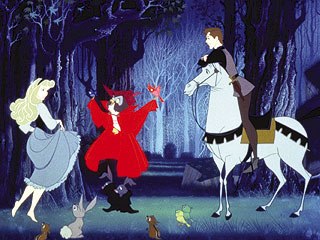In this month's column on the excesses of interactivity, Martin Goodman [insert your own text here].

In the beginning there was analog and the antenna and, lo, they did suck. Televisions did contain but 13 snowy channels (of which mayhap eight were available on a fortunate day), and we beheld The Flintstones in black and white. Speakers of tinny sound flanked its wooden sides and the remote, yea, was unknown unto us. If you remember this not, rejoiceth; ye missed not much.
Flash forward from ye olden days: As television sets and modes of transmission improved over the past few decades, the clunky, humble box of tubes grew to be a thin, sleek, plasma-powered marvel and the centerpiece of a quadraphonic home theater system. Antennae rust in landfills while high-definition digital signals beamed from orbital satellites brighten the screens. The DVD replaces the videotape. Each improvement markedly trumps the last. Until now.
The Blu-ray disc was the next step in DVD technology and in many ways it delivered. There is no question that this new medium has taken full advantage of high-definition format. Using a shorter wavelength (405 nanometers) powered by a blue (well, actually violet) laser, the Blu-ray disc has superior storage and can visually outperform any standard DVD (650 nanometers). Until home-theater holography comes along, there may in fact be nothing better. However, a good thing has been tinkered with to a ludicrous degree. Enter BD Live, a high-definition video disc format that has the ability to connect to the Internet.
So, what will owners of this disc be able to do? They can chat throughout the entire picture directly on the movie screen through the use of a laptop, PDA, or BlackBerry. Those who wish can stick customized photos and accompanying video messages into the film anyplace they so desire, and email them through a special "movie mail" feature. One of the most-awaited classics to get this do-over will be Walt Disney's 1959 film Sleeping Beauty. Disney is providing a protected network specifically for those who wish to employ these wondrous features.
On inserting the disc, one sees that Princess Aurora's castle and its background have a "real-time" function that will reflect actual weather conditions in the viewer's location, in case one can't see out of the nearest window. There will be trivia games, as well as a feature that channels constant movie trailers to the viewers, and those who use the above features get reward points that can be cashed in for goodies such as wallpaper and custom ringtones. Oh yes, I nearly forgot -- if you are so inclined, you can even watch Sleeping Beauty.
Bob Chapek, president of Walt Disney Studios Home Entertainment, believes that this frippery "will revolutionize the way people will interact with and view movies in the home. We pulled out all the stops in launching this technology." I suppose it's not enough that people today are thoroughly immersed in communications technology to the point where they endanger themselves driving, and the minutiae of an entire world is on display 24/7 on YouTube. It's not enough to have blogs, Facebooks, MySpaces, nonstop text messaging, and network gaming with digital avatars. Now we have the option to spill ourselves into the classic animated movies we simply used to watch.
There's a word for this sort of thing, and regular readers of Wired ain't gonna like it.
It's damned stupid. I am still waiting for an explanation as to why anyone, for any reason, has to interact with a movie. Does this actually enhance a viewing experience or does it detract from it? How much is a young girl enjoying Sleeping Beauty when all she is doing is waiting for the right frame of film in which to insert her photo, duly dressed like Princess Aurora, and then emailing it to all her friends, and grandma too? How does one pay any attention to the movie or even gain a sense of continuity when one is typing inane messages over it while it plays? How does one follow the plot while engaging in the technological multitasking that so many of us perform unthinkingly these days?
Finally, why should this be more fun than watching the movie? If I remember correctly, film is indeed an interactive experience, but this is typically achieved by watching it, giving attention to the story and characters, and allowing the piece of art to arouse certain emotions in the viewer. Those who are more analytical might concentrate on foreshadowing, symbolism, mise-en-scene, or perhaps enjoy finding elements of homage to other filmmakers who have worked in the genre. Either way, the film speaks to you; unless you want to get tossed out of the theater, you do not speak to it -- except in the realm of your own emotions or intellect. That is the true interactive experience of cinema.
Although I have critiqued many films, I have never had the urge to alter one by injecting my own alien presence into a piece of work. Sleeping Beauty was created and produced by people who had no earthly idea who I am. They never intended for me to intrude upon their movie, even in the privacy of my home. I have seen films that have transported me and films that I have loathed, but in every case I have given them the respect of playing them uninterrupted as they expressed whatever story and meaning their creators imbued them with. Sleeping Beauty is not a great film; it suffers from a shortage of story and action, a showy surfeit of style, and too many uninteresting characters. Still, it deserves better than to be scribbled on by an inattentive audience.
Why should this "enhancement" even be considered? The only thing I have been able to conclude after researching countless articles on BD Live is that the Blu-ray format is taking a dive, and that the perceived best cure is to stuff them full of new gimmicks. According to a recent article in USA Today, sales of Blu-ray disc players fell 40% from January to February of 2008 and recouped a measly 2% of that shortfall in March. This has something to do with whether the discs are interactive enough? For anyone who believes that, I have a BD Live bridge in virtual Manhattan to sell you, complete with Monster A/V cables.
In reality, it's a bit much to ask, when a quality Blu-ray player can run between $500-$800 and the discs are $10-$15 more than standard DVDs. With gasoline spurting to $4 a gallon, food prices skyrocketing, the dollar progressively weaker, and the house that surrounds the entertainment center facing foreclosure, the price just may seem a bit steep. Viewers' pockets might trump viewer preferences in such cases, and those among the less fortunate gentry may have to make do with high-end standard DVD players hooked up to their 50" plasma flat screens and home-theater receivers.
Not only that, current Blu-ray players, those $500-$800 gadgets you just bought, can't do BD Live until Sony and Panasonic tuck Blu-ray Profile 2.0 into their machines later this summer. Blu-ray Profile 2.0 will be operating more like a jazzed-up PS3 player, and won't come cheap. Want to upgrade your existing BD player to do the same? Well, you can't. That's right. Want to downgrade your existing BD player to a shelf at the local Goodwill? Thank you for your donation; do you need a receipt, sir or madam?
Some consumers may even give up altogether; movies are increasingly available through downloads, and the most humble PCs these days are equipped to handle them. It's no big deal to connect to your flat-screen anymore, and once you have your downloaded movie it's there to enjoy. You might not be able to chat onscreen or make faces at the villain in the service of entertaining email recipients, but do you really have a problem with that? Blu-ray Live is actually designed to reverse the trend of choosing downloads over discs; don't be surprised if they speed it up instead.
Flash forward again from this date: Once upon a time, in a far-off land known as Your Neighborhood, there was a dark and mysterious cavern known as a movie theater. You went there to watch movies, and once there, you had the freedom to concentrate on and enjoy a picture. Some in those bygone days called it "experiencing a film." All distractions were handled by creatures called "ushers." If the movie was a good one (or even if not), you could analyze it in your own mind, reflect on it, and re-experience whatever thoughts or feelings it left you with.
Yes, that was once upon a time. Now it seems you can just type all over the movie, or email pieces of it featuring your dog's face, if that's what you feel like doing. Call me a dinosaur, a Luddite, or an old fogey if you will; I can go the rest of my life and still enjoy hundreds of movies without having to "interact" with them. What's next, an interactive drawing pad that allows one to draw mustaches, Groucho glasses and blacked-out teeth on Maleficent? It is not often that technology diminishes what it was designed to enhance, but it's difficult to think of a clearer case than Blu-ray Live.
Martin "Dr. Toon" Goodman is a longtime student and fan of animation. He lives in Anderson, Indiana.









